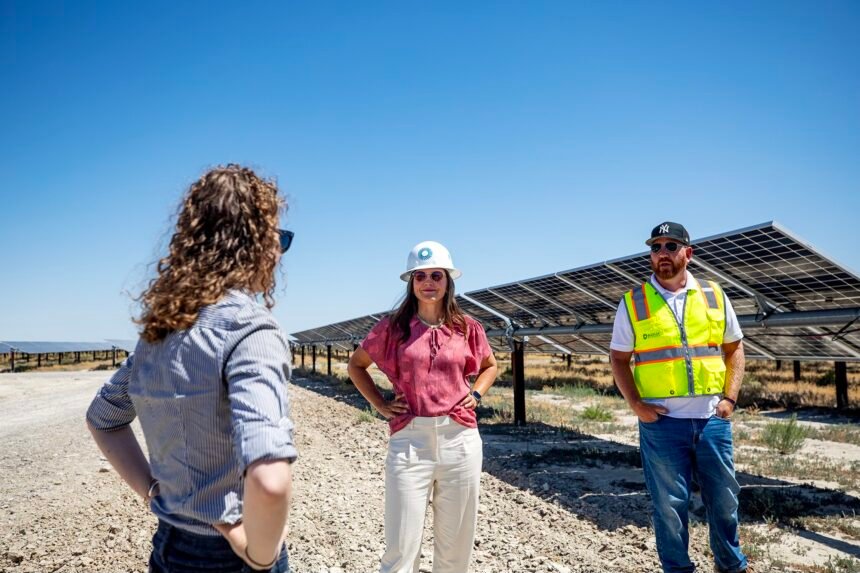Last September, EarthDay.org announced that the global theme for Earth Day 2025 would be “Our Power, Our Planet.” In the press release, the organization explained, “Renewable energy is not only cleaner and healthier — it represents a huge economic opportunity and will create 14 million new jobs globally. In 2023, renewable energy, worldwide, was worth $1.21 trillion and is projected to grow 17.2% annually from 2024 to 2030.”
Earlier this year, EarthDay.org published its list of “6 Unexpected American Cities Leading the Way in Renewable Energy.” It acknowledged that the topic of clean energy often leads people to think of solar farms in California or wind turbines off the East Coast, for example. “However, this couldn’t be further from the truth,” the environmental movement wrote. “In reality, much of the United States’ clean power production happens in the politically diverse heartland of Middle America, with some of the most exciting renewable energy transitions occurring in unexpected places.”
One of these places is Salt Lake City, Utah. The city built a one-megawatt (MW) solar farm on a landfill and saw rooftop solar increase at “roughly exponential rates from 2010-16,” it described in its Climate Positive 2040 document. Then, in 2016, the Salt Lake City Mayor and City Council adopted a joint resolution establishing renewable energy and carbon emissions reduction goals, including a target of 100% renewable energy by 2032, with an intermediate goal of 50% municipal renewable energy by 2020, and an 80% reduction in carbon emissions by 2040. That same year, the city entered a Rocky Mountain Power program called Subscriber Solar, through which it committed to purchasing three MW of clean energy, more than double the amount used for municipal operations at that time.
In 2019, an updated joint resolution advanced the former goal to reach 100% renewable energy by 2030. To help reach that goal, the city government contracted to purchase electricity from Rocky Mountain Power’s 80 MW Elektron Solar project in Tooele County, enough capacity to power 19,700 residences annually. During construction, the project supported 100 construction jobs, and it continues to provide revenue for both the county and the landowner, Utah’s School and Institutional Trust Lands Administration.
Last April, the solar site became operational. In a press release, Salt Lake City Sustainability Director Debbie Lyons reflected, “The success of this project shows what happens when you set inspiring goals, work with the right partners, and refuse to give up. It delivers on a promise Salt Lake City leaders made nearly eight years ago: to source the majority of our electricity for municipal operations from renewable energy. And starting this month, that promise becomes reality.” Salt Lake City buys about half of the energy produced by the solar farm, which covers approximately 80% of its annual municipal operations.

Photo Courtesy Summit County, Utah
Energy efficiency in buildings is also a key part of Salt Lake City’s strategy. In 2017, the City Council passed the “Energy Benchmarking & Transparency Ordinance,” with the primary goals of reducing energy costs and the local carbon footprint while improving air quality. Essentially, buildings over 25,000 square feet are required to benchmark their energy use under the ordinance annually. “That is all,” explained Vicki Bennett, Director of the Sustainability Department. It’s then up to building owners and managers to decide if they want to make voluntary energy efficiency improvements that will save them money. We think they will after seeing the dollars and cents they’ll save.” The ordinance is projected to save building owners $15.8 million in energy costs per year. In collaboration with Energy Star, the Elevate Buildings program also clearly outlines to owners of underperforming buildings the possible adjustments to be made.
Indeed, some of the city’s energy efficiency endeavors have been in existence for far longer. In 2005, the Public Utilities Department began capturing methane at the wastewater plant to power two electrical generators, and in 2006, it initiated testing a solar hot water system at Fire Station #8. That same year, the city committed to achieving the LEED Silver standard for all new city buildings and renovations. This commitment was followed by a 2013 executive order that declared that all new city buildings exceeding 10,000 square feet would be evaluated for net-zero capability. In 2018, Fire Stations #14 and #13 became the first two net-zero fire stations in the U.S. Additionally, by using LED lights in all of its traffic signals, the city has saved more than $100,000 annually.


Photo Courtesy Salt Lake City Green
Clean transportation has also been central to Salt Lake City’s journey. After drafting an Electrified Transportation Roadmap in 2018, the city adopted an Electrified Transportation Resolution in 2020 with goals for electrifying its fleet and encouraging the state’s transit authority and private smart mobility providers to do the same. In 2023, Salt Lake City adopted new standards for parking at new or updated apartment buildings that required 20% of spaces to be compatible with electric vehicle (EV) charging. It also completed a Community Electrified Transportation Study at the beginning of this year, which provides methods to deliver the goals of the 2020 resolution.
As of the beginning of last year, the city had a fleet of 404 vehicles powered by alternative fuels, including 54 fully-electric vehicles, including for its Parking Enforcement officers. The airport maintains an additional 270 alternative-fuel vehicles, 68 of which were fully electric. Last year, there were also 7,413 battery electric and plug-in hybrid EVs registered in the city, compared with 2,012 in 2019. As of July of last year, there were 451 Level 2 charging ports or plugs and 55 DC fast charger ports installed in the city, all of which were available to the public. The city itself owns 24 Level 2 charging stations and 48 ports.


Photo Courtesy Salt Lake City Green
Salt Lake City is also taking the lead in a state-wide clean energy initiative. After the Utah legislature passed the Community Renewable Energy Act, now called the Community Clean Energy Act, in 2019, setting the rules for the launch of a community renewable energy program, Salt Lake City joined with other communities in 2020 to take the discussion to the next level. In 2022, it became one of 18 communities to formally join the Utah Renewable Communities program, followed by one more in 2024, bringing the total to 19, amounting to 2.8 million Rocky Mountain Power customers. For a small fee of $3 to $4 per month, these customers can add clean energy from local utility-scale projects to their electricity mix, although the option to opt out is available. The program will be fully operational next spring, launching a new chapter in Salt Lake City’s renewable energy story and marking a step closer to the net-100% clean electricity goal.


Photo Courtesy Utah Renewable Communities











